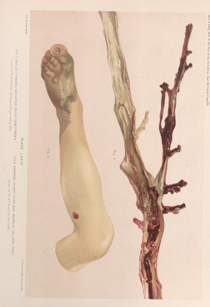Title: Steel, W.
Source text: The Medical and Surgical History of the War of the Rebellion. (1861-65.), Part 3, Volume 2 (Washington, DC: Government Printing Office, 1883), 818, 850.
Civil War Washington ID: med.d2e28724
TEI/XML: med.d2e28724.xml
CASE 1209.—Private W. Steel, Co. G, 70th New York, aged 26 years, was wounded in the left leg, at Manassas Gap, July 23, 1863, and entered Lincoln Hospital, Washington, one week afterwards. Assistant Surgeon H. Allen, U. S. A., recorded the following description of the injury: "The ball struck on the outer side of the leg, passing in a straight line inward through the upper part of the belly of the gastrocnemius, and coming out on the inner side of the calf. The bleeding was copious. Immediately after the reception of the wound the man experienced a severe pain in the ankle and was totally unable to walk, only dragging the limb after him. When admitted into Lincoln Hospital the foot had become bluish, which appearance the patient stated had come on two days previously. The pain in the ankle passed off the first evening, but when the blueness commenced the pain reappeared and continued to increase in severity until the date of amputation. The color of the foot was that of bluish stone, but not shrivelled, the toes being of a deeper hue than the rest. This appearance gradually increased up to the ankle, and then ran up posteriorly to the lower third of the leg. Amputation through the wound was performed by flap method on August 3d. After the operation the constitutional symptoms, such as pale and tremulous tongue, quick and feeble pulse, continued about the same. The flaps were pale and rather flabby, but not gangrenous. A diarrhœa set in, which was checked by August 25th; appetite capricious. By October 20th had entirely recovered, the stump having healed without exfoliating any bone." On January 30, 1864, the patient was discharged from service and pensioned, and subsequently he was furnished with a "Palmer" artificial leg. In his application for commutation the pensioner describes the stump as being in a healthy condition. He was paid December 4, 1880. A representation of the gangrenous limb is given in PLATE LXXIX, opposite p. 818.
